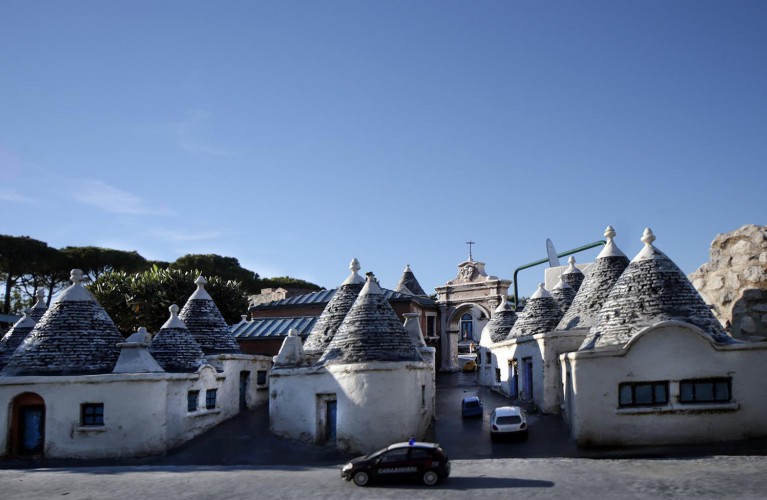
The castle was built around 1240 by Frederick II of Swabia as his residence and hunting lodge.
The massive octagonal structure with its 8 octagonal towers is enhanced by its solitary location on the top of a hill. The building had all the comforts that made it suitable to be an imperial residence. Many rooms were heated by enormous fireplaces, and there was also a system to collect rainwater, channelled into a cistern in the courtyard or sent towards the toilets that were located in three towers on each of the two floors. But many mysteries surround this unique castle.
The size and proportions of Castel del Monte are calculated based on the golden section, but also in relation to the shadows determined by the sun when it enters the different zodiacal signs, revealing to be the summa of the astronomical, mathematical and philosophical studies of the numerous Greek, Latin, Arab scholars at the court of Frederick II.
The basilica is one of the most complete and refined examples of Apulia-Romanesque architecture. It was started in the seventh century and was finished in the middle of the thirteenth century.
The plain but svelte façade, rising above the crypt, has a precious bronze door sculpted by Barisano di Trani in 1179. Grafted onto the façade is a high bell tower resting on mighty arches. The sides rest on high blind arches and between one arch and the next are magnificent statues of animals.
Stretching over the waters which separate the island of the old town of Taranto from the modern area of town on dry land is the Ponte Girevole (bascule, or lifting bridge). It was built in 1886 and reconstructed in 1958 and is made up of two arms which open up in little more than two minutes, leaving the waterway free for the passage of ships.
The Aragonese Castle was commissioned by Ferdinand I of Aragon at the end of the fifteenth century, later to be enlarged by the Spanish in the sixteenth century. This beautiful castle, with round towers joined by thick walls and ramparts, overlooks the navigable channel between the Mar Grande (Big Sea) and the Mar Piccolo (Small Sea) and is home today to the headquarters of the Navy as well as housing a Naval Museum.
At the highest point of the mountain ridge where the village is located stands the Castle of Monte S. Angelo. The fortress grew in importance under the Normans: Robert Guiscard built the castle and the walls around the village. It was later restored and enlarged by Frederick II.
Other sections were added during the Aragonese period: two cylindrical towers and an almond shaped rampart. The so-called tower of the Giganti is the oldest part of the fortress: 18m high, it has walls 3.7m thick.
The stone was laid in memory of the battle in 216 BC between the victorious Hannibal and the Romans. It is a cut-off cylindrical column in marble placed upon a square base.
At the top of a flight of steps overlooking the Roman gateway rises one of the columns signing the end of the ancient Via Appia which linked Rome to Brindisi. It is 19 metres high and crowned with a splendid capital.
The other column collapsed in 1528 and only the base and drum are left. It was near this column that Virgil, the greatest of Latin poets and author of the Aeneid, died in 19 BC.
The Basilica di San Nicola is considered one of the most important churches in southern Italy. Construction work started in 1087 under the direction of the Elia friars.
The Basilica has a very upright structure, probably due to Norman influences. We also find influences of the Po Valley Romanesque style in the façade: the façade is divided into three sections through the use of half-pillars which correspond with the interior division of the three naves, the windows and the small loggia off to one side.
The façade is flanked by two incomplete towers which appear to have been built at a later date.
Trulli are characteristic cylindrical buildings constructed of limestone chips, known locally as "chiancarelle", topped with dome-shaped roofs made with concentric rings of stone.
Their structure and shape are of ancient origin; the earliest date back to the sixteenth century when the Counts of Acquaviva established a small community in the Silva Alberusi Belli area and prohibited the use of conglomerated building materials in order to avoid registering permits and paying taxes. The trulli spread throughout the centre of the town, including the districts known as the "Rione Monti" (hill quarter) and the "Aia Piccola" (little barnyard) which are made up entirely of trulli, clustered together in groups and lining the steep, narrow streets which wind up the hillside.
Above their walls, which are carefully whitewashed, rise the grey stones of the dome. The highest and most complete example, the so-called "Sovereign Trullo" is on two-storeys and can be found in a small square behind the "Chiesa Madre" church.